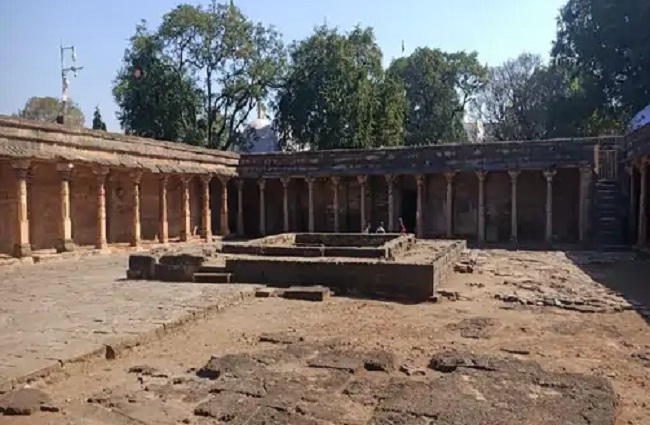Bhopal, 15 July: The survey report of the Archaeological Survey of India (ASI) which went on for 98 consecutive days in the historic Bhojshala case located in Dhar district headquarters of Madhya Pradesh has been presented in the Indore bench of Madhya Pradesh High Court.
Archaeological Survey of India (ASI) lawyer Himanshu Joshi presented the report in Indore High Court on Monday. All the parties have been instructed not to share this report with the media. It has been learned that this report is in more than 2000 pages. More than 1700 evidences and remains found during the survey and excavation have been included in this report.
Hearing on this will be held on 22 July. ASI’s lawyer Himanshu Joshi said that the report of the scientific survey done with the latest technology has been presented. He says that the report is of two thousand pages. Nothing more can be told than this. This report includes more than 1700 evidences collected in the survey that lasted 98 days and analysis of the remains found in the excavation. One copy of this report has been made available to all the parties involved in the case. Despite this, what is in the report, it still remains a mystery. Only after this report is made public, it will be known whether Dhar Bhojshala is a temple or a mosque.
Meanwhile, people of the Hindu side are claiming that the survey report that has been presented will make it clear that it was built by Raja Bhoj. Ashish Goyal, the petitioner of the Hindu side claimed that on the basis of the survey that was done in front of us, we are saying that this building will be proved to be of the period of Raja Bhoj, which was built in the year 1034. ASI has found many ancient statues in this survey, which may be of the Parmar period. In this way, this is a Parmar period building.
He said that from the remains found during the survey, it is almost certain that it is a construction of Parmar period i.e. between 9th to 11th century. Meanwhile, a 27 feet long wall has also been found near the sanctum sanctorum, which is made of bricks. Archaeologists believe that construction was done with bricks in even more ancient times. At the time of Mohenjodaro civilization, that is, this place can be even more ancient. Hindu for Justice had filed a petition It is worth noting that there has been a dispute over Bhojshala for decades.
Hindu for Justice had filed a petition before the Indore Bench of the MP High Court a year ago, pleading to stop the Friday Namaz in the Bhojshala premises.
The petitioner says that Hindu people worship in Bhojshala on Tuesday and Muslim people desecrate it by offering Namaz there on Friday. During the hearing, the court had ordered on March 11, 2024 that ASI should conduct a scientific survey of Bhojshala and submit the report to the court. This survey lasted 98 days.
According to the website of the district administration, Bhojshala was built by Raja Bhoj. It was a university in which the statue of Vaagdevi was installed. The Muslim ruler converted it into a mosque. Its remains can be seen in the famous Maulana Kamaluddin Mosque. It is located in the campus of Bhojshala while the statue of the goddess is kept in a museum in London. In the years 2006, 2012 and 2016, when Vasant Panchami fell on Friday, a situation of controversy arose. On Vasant Panchami, the Hindu side is allowed to perform Puja while since it is Friday, Muslims are allowed to offer Namaz. In such a situation, when Vasant Panchami falls on Friday, both Puja and Namaz are performed as per the agreement.





